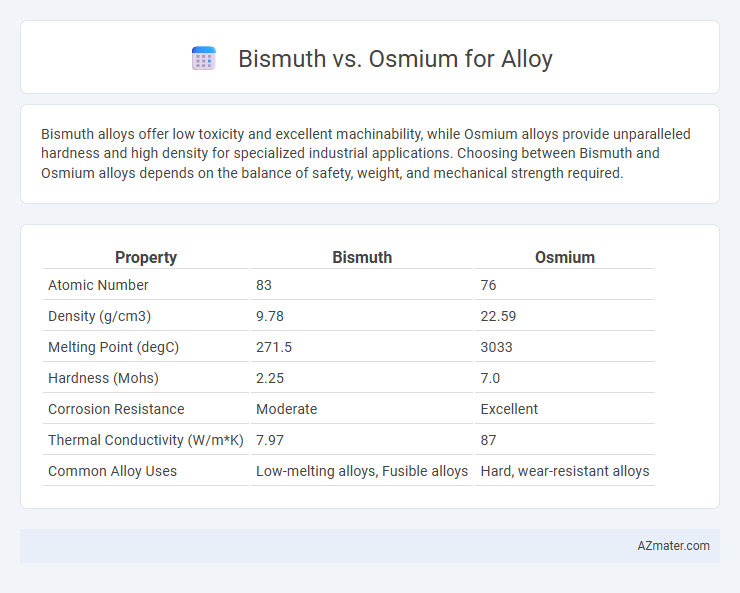Bismuth alloys offer low toxicity and excellent machinability, while Osmium alloys provide unparalleled hardness and high density for specialized industrial applications. Choosing between Bismuth and Osmium alloys depends on the balance of safety, weight, and mechanical strength required.
Table of Comparison
| Property | Bismuth | Osmium |
|---|---|---|
| Atomic Number | 83 | 76 |
| Density (g/cm3) | 9.78 | 22.59 |
| Melting Point (degC) | 271.5 | 3033 |
| Hardness (Mohs) | 2.25 | 7.0 |
| Corrosion Resistance | Moderate | Excellent |
| Thermal Conductivity (W/m*K) | 7.97 | 87 |
| Common Alloy Uses | Low-melting alloys, Fusible alloys | Hard, wear-resistant alloys |
Introduction to Bismuth and Osmium Alloys
Bismuth and osmium alloys exhibit distinct properties valuable in advanced materials engineering due to their unique atomic structures and densities. Bismuth alloys are prized for low toxicity and excellent machinability, making them ideal for non-toxic metal alternatives in plumbing and fire safety applications. Osmium alloys offer exceptional hardness and high density, suitable for applications requiring durability and wear resistance, such as electrical contacts and fountain pen nibs.
Chemical Properties Comparison
Bismuth exhibits low toxicity, brittleness, and is highly diamagnetic, making it ideal for low-melting alloys and thermal applications. Osmium, a dense, hard, and corrosion-resistant metal, boasts the highest melting point among platinum-group metals and is characterized by high oxidation states and catalytic properties. The contrasting chemical properties, with bismuth's tendency to form stable alloys with low melting points and osmium's resilience and oxidation resistance, influence their distinct roles in alloy formulation.
Physical Characteristics: Density and Hardness
Bismuth has a density of approximately 9.78 g/cm3 and is relatively soft with a Mohs hardness around 2.5, making it ideal for low-density, machinable alloys. Osmium ranks among the densest metals with a density of about 22.59 g/cm3 and exhibits exceptional hardness, approaching a Mohs hardness of 7, which provides significant wear resistance in high-performance alloys. The stark contrast in density and hardness between bismuth and osmium allows engineers to tailor alloy compositions for specific applications requiring either lightweight properties or extreme durability.
Alloying Behavior and Compatibility
Bismuth exhibits limited solid solubility and tends to form low-melting, brittle phases when alloyed with most metals, showing poor compatibility in high-strength applications. Osmium, with its high melting point and robust crystal structure, integrates more effectively into alloys, enhancing hardness and corrosion resistance without compromising ductility. Their contrasting alloying behaviors impact compatibility, where osmium serves as a stable reinforcement element, while bismuth often acts as a grain refiner or lubricant additive in specialized low-strength alloys.
Corrosion Resistance: Bismuth vs Osmium
Osmium exhibits superior corrosion resistance compared to bismuth, making it more suitable for alloys exposed to harsh chemical environments. While bismuth is relatively soft and prone to oxidation, osmium's dense crystal structure and high melting point contribute to its remarkable stability against corrosion. Alloys containing osmium benefit from enhanced durability and longevity in applications requiring resistance to acids, salts, and moisture.
Applications in Industry
Bismuth and osmium alloys serve distinct industrial applications due to their unique properties. Bismuth alloys are widely used in low-melting-point applications like fire detection systems, solders, and metal casting, benefiting from their non-toxic and environmentally friendly characteristics. Osmium alloys, known for exceptional hardness and corrosion resistance, find niche uses in electrical contacts, fountain pen nibs, and high-performance mechanical components requiring durability under extreme conditions.
Toxicity and Environmental Impact
Bismuth is favored for alloy applications due to its low toxicity and environmentally benign properties, making it a safer alternative to heavy metals. Osmium, while offering high density and hardness in alloys, poses significant health risks because of its toxic and volatile oxide forms. The environmental impact of bismuth alloys is considerably lower, as osmium compounds require stringent handling and disposal procedures to mitigate toxicity concerns.
Cost and Availability of Bismuth and Osmium
Bismuth is significantly more abundant and cost-effective than osmium, making it the preferred choice for alloy production when budget and availability are critical factors. Osmium is one of the rarest and densest elements, with limited supply and a considerably higher market price, restricting its widespread use in commercial alloys. The substantial cost difference and easier procurement of bismuth enhance its practicality for industrial applications compared to the scarce and expensive osmium.
Performance in High-Temperature Environments
Bismuth offers limited high-temperature performance due to its low melting point of 271degC, making it unsuitable for high-temperature alloy applications. Osmium, with a melting point of about 3033degC and exceptional hardness, provides superior stability and durability in extreme thermal conditions. Alloys containing osmium exhibit enhanced wear resistance and thermal endurance, crucial for high-temperature industrial applications.
Pros and Cons: Choosing the Right Metal for Alloys
Bismuth offers benefits in alloys such as low toxicity, excellent machinability, and a low melting point, making it ideal for applications requiring environmental safety and ease of fabrication. Osmium provides superior hardness, high density, and exceptional corrosion resistance, suited for high-performance and wear-resistant alloys but is limited by its brittleness and high cost. Selecting the right metal depends on balancing bismuth's eco-friendly properties and workability against osmium's durability and stability under extreme conditions.

Infographic: Bismuth vs Osmium for Alloy
 azmater.com
azmater.com